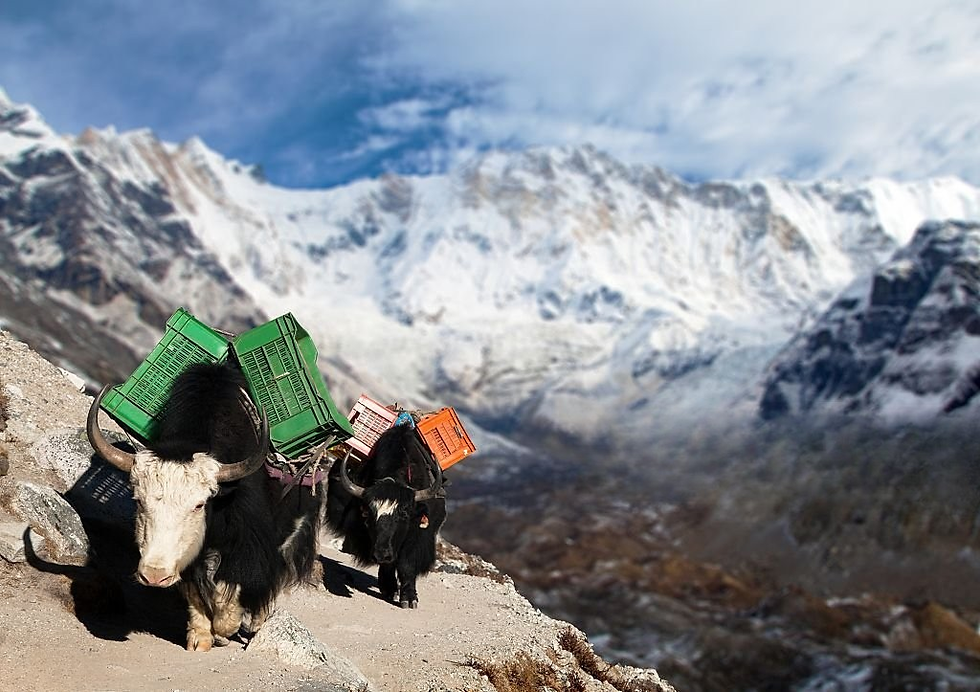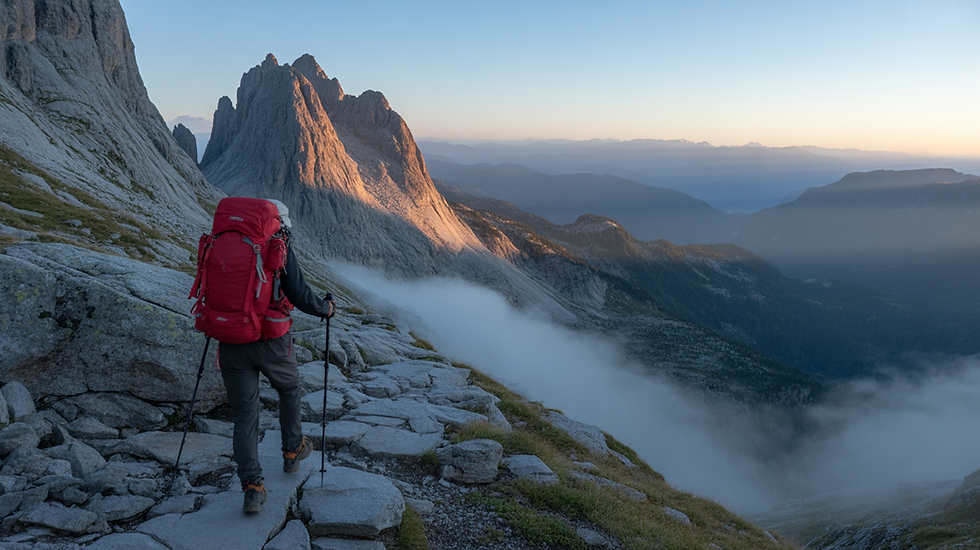Top Things to See and Do in Nepal’s Annapurna Region
- Ava

- Sep 2, 2025
- 7 min read
Ever wanted to escape into the mountains where snow-capped peaks touch the sky and ancient trails whisper stories of old? Nepal’s Annapurna region is calling your name. This isn’t just another hiking destination, it’s where nature, culture and adventure collide in the most epic way.
Travelers come here for more than just the views. Annapurna region offers a rare mix of natural beauty, spiritual depth and welcoming local communities. Whether you’re a seasoned trekker or a curious traveler looking for meaning beyond the usual tourist spots, this place has something personal for you.

But with so many trails, villages and attractions, it can be hard to know where to start. That’s where this guide comes in. “Top Things to See and Do in Nepal’s Annapurna Region” helps you cut through the noise and focus on what matters. From iconic treks like the Annapurna Circuit Trek to hidden hot springs and sacred temples, we’ll show you what not to miss.
So lace up your boots, pack your sense of wonder and get ready to explore one of the most incredible corners of the Himalayas. Let’s get started and uncover the best of the Annapurna region, step by step.
Why is the Annapurna Region a Top Travel Destination in Nepal?
Annapurna Region is one of Nepal’s most popular trekking destinations, attracting adventurers, nature lovers and cultural enthusiasts from all over the world. Located in north-central Nepal, this region is home to the majestic Annapurna Massif which includes Annapurna I (8,091 meters), the 10th highest peak in the world. This area has a wide range of altitudes from subtropical forests to high alpine terrain making it one of the most bio-diverse trekking zones in the Himalayas.
What truly sets the Annapurna Region apart is its accessibility and variety. Whether you’re an experienced mountaineer or a casual traveler, there’s a trail or experience for you. The region is dotted with traditional villages, ancient monasteries and terraced farmlands giving you a deep insight into Nepalese culture. Trekkers can interact with Gurung, Thakali and Magar communities known for their hospitality and rich heritage.Wildlife and flora also make this region special. Annapurna Conservation Area, Nepal’s first and largest conservation area, protects a wide range of species including snow leopards, Himalayan tahr and over 450 species of birds. Rhododendron forests bloom in spring, turning trails into vibrant corridors of color.
For spiritual seekers, Annapurna Region offers moments of deep connection. Many trails pass through sacred sites and Buddhist chortens adding a meditative quality to the journey. Whether you’re watching the sunrise over Machapuchare or sipping butter tea in a mountain village, Annapurna Region has experiences that will stay with you for life.
This is the perfect place to combine adventure with cultural immersion. With well-established trekking infrastructure including teahouses, lodges and local guides, it’s a safe and welcoming destination. Whether you’re aiming to cross the Thorong La Pass or simply soak in the views from Poon Hill, Annapurna Region has unforgettable moments at every turn.
In short, Annapurna Region isn’t just a destination, it’s a transformative experience. With its mix of natural beauty, cultural richness and trekking accessibility, it’s one of the top travel destinations in Nepal and a bucket-list journey for many around the world.
Best Treks in Annapurna Region for Adventure Seekers
Is Annapurna Circuit Trek worth it?
Yes. Annapurna Circuit Trek is often considered one of the best long-distance treks in the world. Spanning 160–230 kilometers depending on your route, it offers an unparalleled variety of landscapes from subtropical forests and terraced rice fields to alpine meadows and high-altitude desert.
A major highlight of this trek is crossing the Thorong La Pass at 5,416 meters (17,769 feet), one of the highest trekking passes on Earth. The sense of accomplishment at the top combined with panoramic views of Annapurna and Dhaulagiri ranges is unmatched.
Along the way, trekkers pass through culturally rich villages like Manang and Marpha where you can learn about Buddhist traditions and enjoy local apple brandy.The trek takes 14–20 days depending on acclimatization and side trips.
It’s moderately to highly challenging, requires good physical fitness and preparation. High altitude trekking can cause altitude sickness; consult a health professional and plan acclimatization days accordingly.
Permits are required: you’ll need Annapurna Conservation Area Permit (ACAP). This can be obtained in Kathmandu or Pokhara.
Annapurna Circuit also has good infrastructure. Teahouses and guesthouses are available throughout the trail, with meals and basic accommodation. Many now have Wi-Fi and hot showers, though services become more basic at higher elevations.
In short, Annapurna Circuit Trek is worth it for those looking for a challenging, diverse and culturally immersive Himalayan adventure. It’s a true classic that lives up to the hype.
What to Expect on Annapurna Base Camp (ABC) Trek?
Annapurna Base Camp Trek is a shorter but equally rewarding alternative to the circuit. It takes 7–12 days and takes you directly into the heart of Annapurna Sanctuary, a natural amphitheater surrounded by towering peaks including Annapurna I and sacred Machapuchare (Fishtail Mountain).
This trek offers a more direct route to high altitude views without the extreme elevation of Thorong La. The highest point is Annapurna Base Camp at 4,130 meters, making it accessible to a wider range of trekkers. The trail passes through beautiful rhododendron forests, terraced fields and traditional Gurung villages like Chhomrong and Ghandruk.
One of the trek’s unique features is the cultural richness. You’ll encounter Buddhist shrines, prayer flags and warm hospitality from local communities. Many trekkers opt for homestays or family run lodges to deepen their cultural experience.
Expect a mix of uphill climbs and stone staircases especially as you approach the sanctuary. The trail can be slippery during monsoon or icy in winter, so proper footwear and trekking poles are essential.
ABC Trek is ideal for those who want high altitude experience without committing to a three-week journey. It’s also great for photographers with dramatic scenery and golden sunrise over the Himalayas.
Are there short treks in Annapurna Region for beginners?
Yes, Annapurna Region is perfect for beginners or those with limited time. Several short treks offer stunning views and cultural encounters without the physical demands of high-altitude trekking.
Ghorepani Poon Hill Trek is the most popular. It takes 3–5 days and rewards you with sunrise over Annapurna and Dhaulagiri from Poon Hill (3,210 meters). The trail passes through rhododendron forests and Gurung villages like Ulleri and Ghorepani, offering a rich cultural experience.
Mardi Himal Trek is another great option. It takes 4–6 days. Less crowded and offers close up views of Machapuchare. The trail ascends through forested ridges to Mardi Himal Base Camp (4,500 meters), providing a sense of solitude and adventure.
For a more relaxed pace, consider Dhampus or Australian Camp Trek. These 2–3-day hikes are perfect for families and offer panoramic views with minimal elevation gain. They’re easily accessible from Pokhara and don’t require intense physical preparation.
All these treks have teahouse accommodations and don’t exceed 3,500 meters, reducing the risk of altitude sickness.
In short, beginners can definitely enjoy Annapurna Region. With the right trek, you’ll get unforgettable views and cultural immersion in just a few days.
Must-see cultural attractions in Annapurna Region
What are the best villages to visit in Annapurna?
Annapurna Region is not just about mountains; it’s also a cultural tapestry of ethnic communities and traditional Himalayan life. Some villages stand out for their heritage, architecture and hospitality.
Ghandruk is a must-visit Gurung village on the route to Annapurna Base Camp Trek. Known for its stone-paved alleys and traditional houses, it offers panoramic views of Annapurna South and Machapuchare. Gurung Cultural Museum here provides insights into local customs, attire and history.
Marpha, in the lower Mustang region, is famous for its whitewashed houses, apple orchards and Thakali culture. The village has a serene charm and its local apple brandy and dried apples are popular among trekkers. Manang, at 3,519 meters, is an acclimatization stop on Annapurna Circuit. It’s rich in Tibetan Buddhist culture with ancient monasteries and chortens all over the landscape. The village also has a Himalayan Rescue Association clinic, offering high altitude education.
These villages are more than just a place to rest; they offer authentic cultural experiences. Many lodges are family run and homestays are becoming popular. You can learn to cook dal bhat, participate in local farming or simply enjoy a cup of butter tea with your host.
How to experience local festivals in Annapurna Region
Timing your trek with a local festival can make your experience even more special. Annapurna Region celebrates several festivals that reflect its cultural diversity.
Dashain and Tihar, Nepal’s biggest Hindu festivals, usually occur in October and November. Not unique to Annapurna but celebrating them in a village like Ghandruk or Ghorepani gives you a more intimate experience. Expect colorful decorations, traditional dances and local feasts.
Yartung is a unique festival celebrated in Mustang and Manang areas in August. It involves horse racing, archery and communal gatherings. Great time to see Thakali and Tibetan Buddhist traditions in action.
To experience these festivals respectfully:
Ask permission before taking photos
Dress modestly and follow local customs
Support local businesses and artisans
Festivals are a great way to connect with the soul of Annapurna Region. They give you a deeper understanding of the people who call this incredible landscape home.
Conclusion
Annapurna region offers more than just mountain views, it’s a cultural, adventurous and natural beauty. From the iconic Annapurna Circuit to serene villages like Ghandruk and spiritual Muktinath, each experience leaves a mark.
Whether you’re a seasoned trekker or a curious traveler, Annapurna region has something for everyone. It’s a place where every step introduces you to new landscapes, warm hospitality and personal discovery.
So, pack your boots, charge your camera and open your heart to the magic of the Himalayas. The Annapurna adventure of a lifetime is waiting, go experience it yourself! And if you’d like extra inspiration for planning, explore these helpful travel guides.



Comments